Consumer Behavior Analysis: Household Decision-Making Report
VerifiedAdded on 2023/01/06
|19
|6345
|43
Report
AI Summary
This report delves into the realm of global consumer behavior, with a specific focus on household decision-making processes. It begins by defining the concept of a household and the intricacies of household decision-making, highlighting the roles of various family members, including children, in the purchasing process. The report then critically evaluates the impact of two key influences on these decisions, such as collective decision making and the role of children. The report also examines the influence of cultural models like Hofstede's model, diffusion of innovation theory, and customer segmentation models. It explains how marketers can use these theories to develop effective growth strategies, target customers, and understand the dynamics of consumer choice. Overall, the report offers a comprehensive analysis of the factors shaping consumer behavior within the context of households, providing valuable insights for marketers and anyone interested in understanding consumer trends.
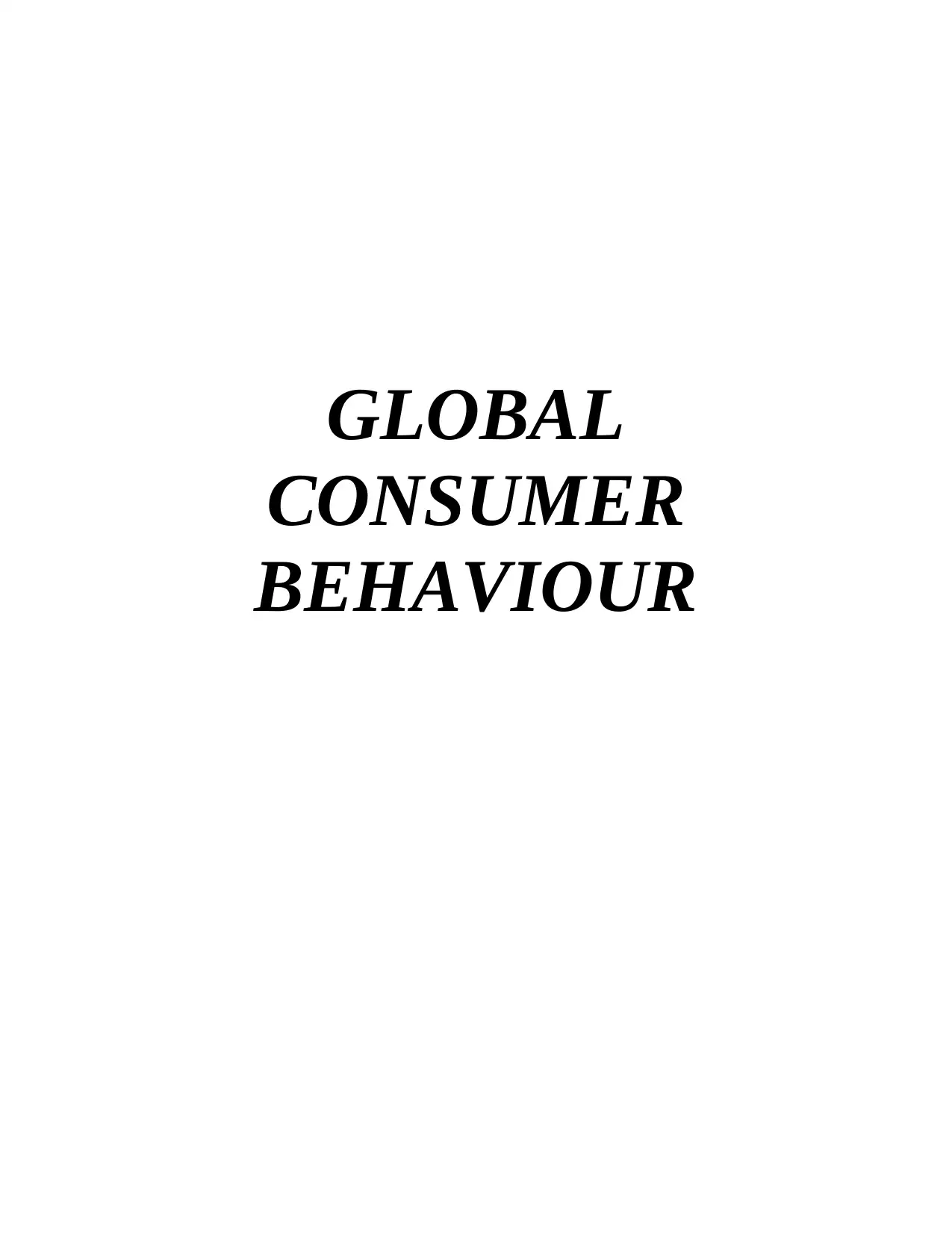
GLOBAL
CONSUMER
BEHAVIOUR
CONSUMER
BEHAVIOUR
Paraphrase This Document
Need a fresh take? Get an instant paraphrase of this document with our AI Paraphraser
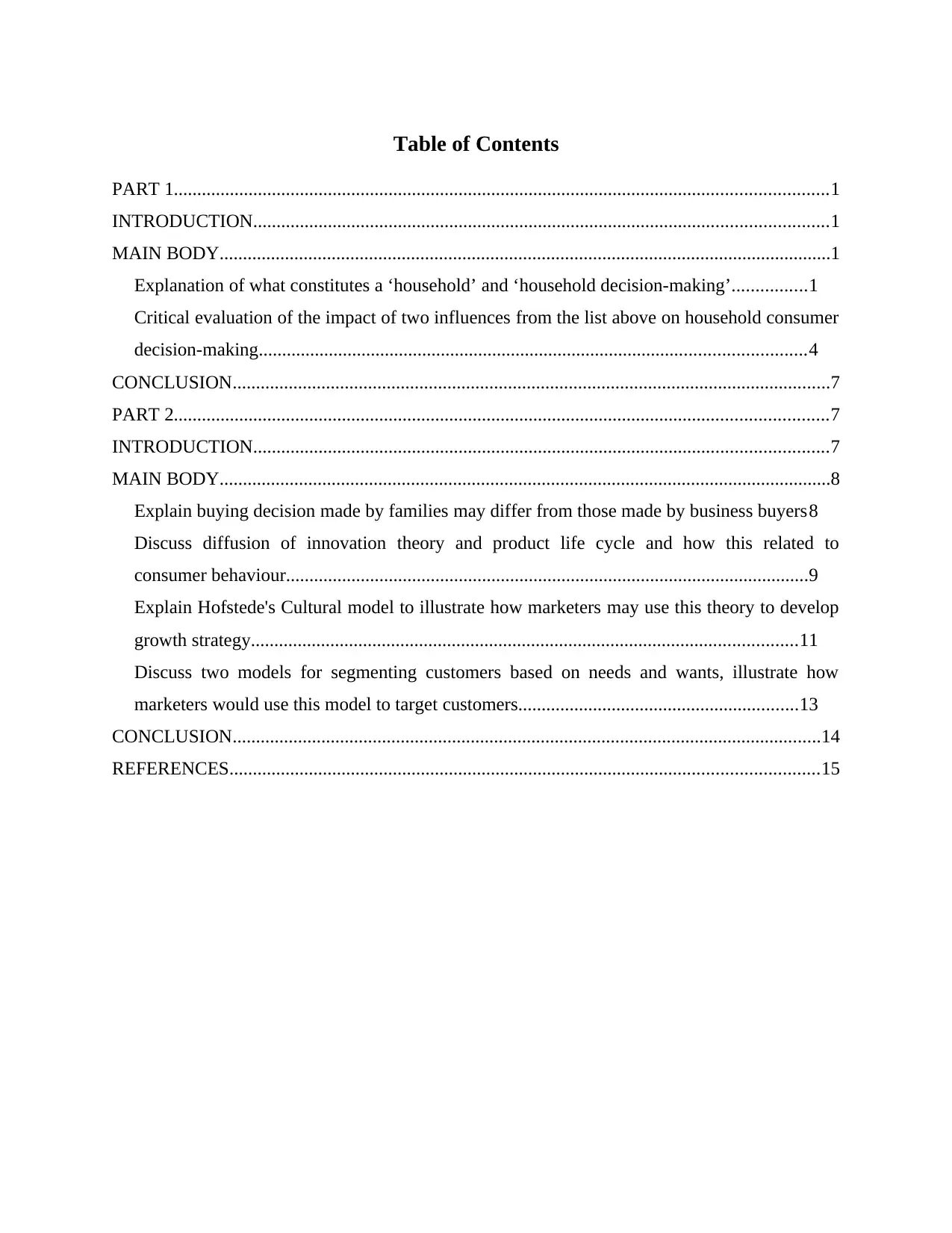
Table of Contents
PART 1............................................................................................................................................1
INTRODUCTION...........................................................................................................................1
MAIN BODY...................................................................................................................................1
Explanation of what constitutes a ‘household’ and ‘household decision-making’................1
Critical evaluation of the impact of two influences from the list above on household consumer
decision-making.....................................................................................................................4
CONCLUSION................................................................................................................................7
PART 2............................................................................................................................................7
INTRODUCTION...........................................................................................................................7
MAIN BODY...................................................................................................................................8
Explain buying decision made by families may differ from those made by business buyers8
Discuss diffusion of innovation theory and product life cycle and how this related to
consumer behaviour................................................................................................................9
Explain Hofstede's Cultural model to illustrate how marketers may use this theory to develop
growth strategy.....................................................................................................................11
Discuss two models for segmenting customers based on needs and wants, illustrate how
marketers would use this model to target customers............................................................13
CONCLUSION..............................................................................................................................14
REFERENCES..............................................................................................................................15
PART 1............................................................................................................................................1
INTRODUCTION...........................................................................................................................1
MAIN BODY...................................................................................................................................1
Explanation of what constitutes a ‘household’ and ‘household decision-making’................1
Critical evaluation of the impact of two influences from the list above on household consumer
decision-making.....................................................................................................................4
CONCLUSION................................................................................................................................7
PART 2............................................................................................................................................7
INTRODUCTION...........................................................................................................................7
MAIN BODY...................................................................................................................................8
Explain buying decision made by families may differ from those made by business buyers8
Discuss diffusion of innovation theory and product life cycle and how this related to
consumer behaviour................................................................................................................9
Explain Hofstede's Cultural model to illustrate how marketers may use this theory to develop
growth strategy.....................................................................................................................11
Discuss two models for segmenting customers based on needs and wants, illustrate how
marketers would use this model to target customers............................................................13
CONCLUSION..............................................................................................................................14
REFERENCES..............................................................................................................................15
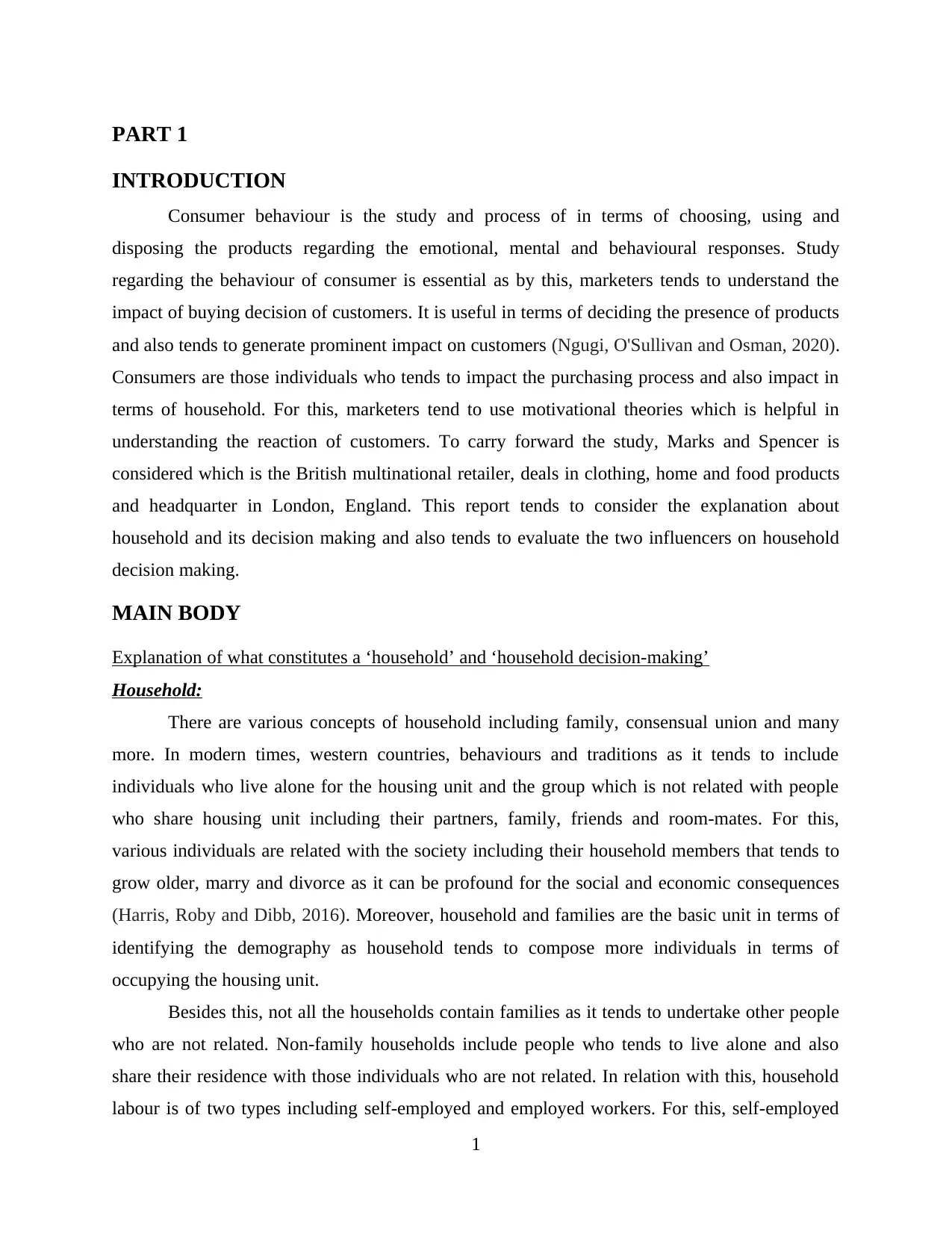
PART 1
INTRODUCTION
Consumer behaviour is the study and process of in terms of choosing, using and
disposing the products regarding the emotional, mental and behavioural responses. Study
regarding the behaviour of consumer is essential as by this, marketers tends to understand the
impact of buying decision of customers. It is useful in terms of deciding the presence of products
and also tends to generate prominent impact on customers (Ngugi, O'Sullivan and Osman, 2020).
Consumers are those individuals who tends to impact the purchasing process and also impact in
terms of household. For this, marketers tend to use motivational theories which is helpful in
understanding the reaction of customers. To carry forward the study, Marks and Spencer is
considered which is the British multinational retailer, deals in clothing, home and food products
and headquarter in London, England. This report tends to consider the explanation about
household and its decision making and also tends to evaluate the two influencers on household
decision making.
MAIN BODY
Explanation of what constitutes a ‘household’ and ‘household decision-making’
Household:
There are various concepts of household including family, consensual union and many
more. In modern times, western countries, behaviours and traditions as it tends to include
individuals who live alone for the housing unit and the group which is not related with people
who share housing unit including their partners, family, friends and room-mates. For this,
various individuals are related with the society including their household members that tends to
grow older, marry and divorce as it can be profound for the social and economic consequences
(Harris, Roby and Dibb, 2016). Moreover, household and families are the basic unit in terms of
identifying the demography as household tends to compose more individuals in terms of
occupying the housing unit.
Besides this, not all the households contain families as it tends to undertake other people
who are not related. Non-family households include people who tends to live alone and also
share their residence with those individuals who are not related. In relation with this, household
labour is of two types including self-employed and employed workers. For this, self-employed
1
INTRODUCTION
Consumer behaviour is the study and process of in terms of choosing, using and
disposing the products regarding the emotional, mental and behavioural responses. Study
regarding the behaviour of consumer is essential as by this, marketers tends to understand the
impact of buying decision of customers. It is useful in terms of deciding the presence of products
and also tends to generate prominent impact on customers (Ngugi, O'Sullivan and Osman, 2020).
Consumers are those individuals who tends to impact the purchasing process and also impact in
terms of household. For this, marketers tend to use motivational theories which is helpful in
understanding the reaction of customers. To carry forward the study, Marks and Spencer is
considered which is the British multinational retailer, deals in clothing, home and food products
and headquarter in London, England. This report tends to consider the explanation about
household and its decision making and also tends to evaluate the two influencers on household
decision making.
MAIN BODY
Explanation of what constitutes a ‘household’ and ‘household decision-making’
Household:
There are various concepts of household including family, consensual union and many
more. In modern times, western countries, behaviours and traditions as it tends to include
individuals who live alone for the housing unit and the group which is not related with people
who share housing unit including their partners, family, friends and room-mates. For this,
various individuals are related with the society including their household members that tends to
grow older, marry and divorce as it can be profound for the social and economic consequences
(Harris, Roby and Dibb, 2016). Moreover, household and families are the basic unit in terms of
identifying the demography as household tends to compose more individuals in terms of
occupying the housing unit.
Besides this, not all the households contain families as it tends to undertake other people
who are not related. Non-family households include people who tends to live alone and also
share their residence with those individuals who are not related. In relation with this, household
labour is of two types including self-employed and employed workers. For this, self-employed
1
⊘ This is a preview!⊘
Do you want full access?
Subscribe today to unlock all pages.

Trusted by 1+ million students worldwide
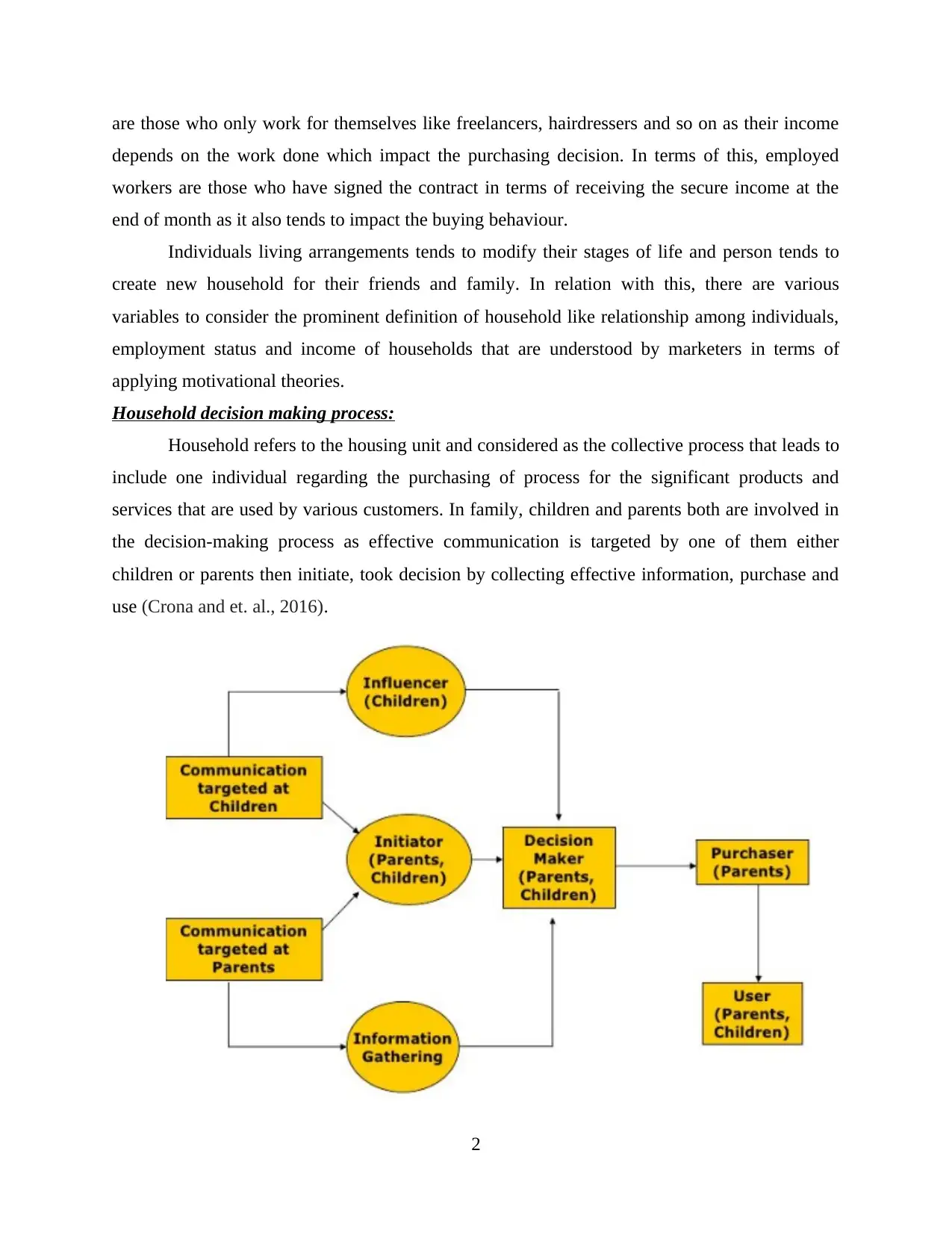
are those who only work for themselves like freelancers, hairdressers and so on as their income
depends on the work done which impact the purchasing decision. In terms of this, employed
workers are those who have signed the contract in terms of receiving the secure income at the
end of month as it also tends to impact the buying behaviour.
Individuals living arrangements tends to modify their stages of life and person tends to
create new household for their friends and family. In relation with this, there are various
variables to consider the prominent definition of household like relationship among individuals,
employment status and income of households that are understood by marketers in terms of
applying motivational theories.
Household decision making process:
Household refers to the housing unit and considered as the collective process that leads to
include one individual regarding the purchasing of process for the significant products and
services that are used by various customers. In family, children and parents both are involved in
the decision-making process as effective communication is targeted by one of them either
children or parents then initiate, took decision by collecting effective information, purchase and
use (Crona and et. al., 2016).
2
depends on the work done which impact the purchasing decision. In terms of this, employed
workers are those who have signed the contract in terms of receiving the secure income at the
end of month as it also tends to impact the buying behaviour.
Individuals living arrangements tends to modify their stages of life and person tends to
create new household for their friends and family. In relation with this, there are various
variables to consider the prominent definition of household like relationship among individuals,
employment status and income of households that are understood by marketers in terms of
applying motivational theories.
Household decision making process:
Household refers to the housing unit and considered as the collective process that leads to
include one individual regarding the purchasing of process for the significant products and
services that are used by various customers. In family, children and parents both are involved in
the decision-making process as effective communication is targeted by one of them either
children or parents then initiate, took decision by collecting effective information, purchase and
use (Crona and et. al., 2016).
2
Paraphrase This Document
Need a fresh take? Get an instant paraphrase of this document with our AI Paraphraser
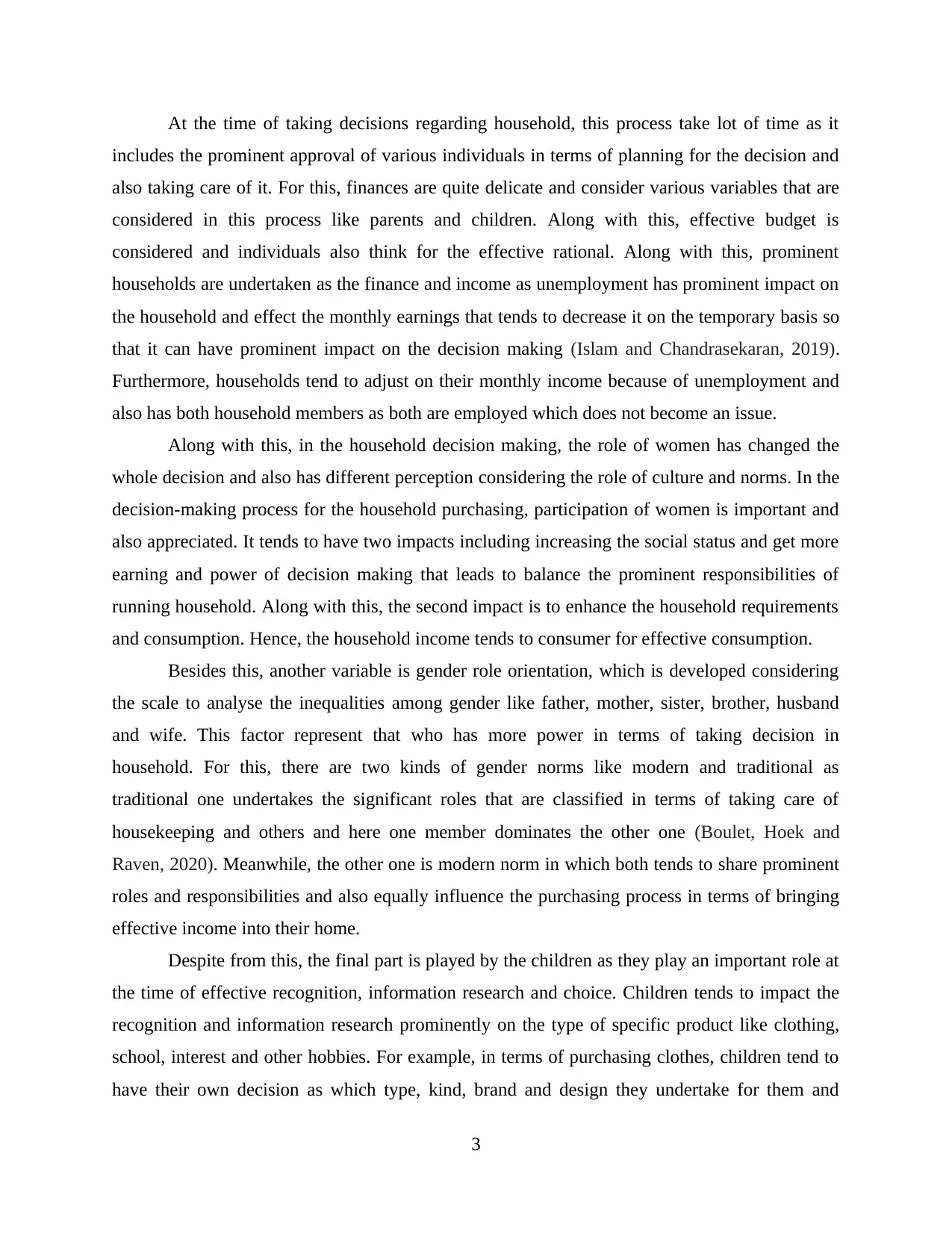
At the time of taking decisions regarding household, this process take lot of time as it
includes the prominent approval of various individuals in terms of planning for the decision and
also taking care of it. For this, finances are quite delicate and consider various variables that are
considered in this process like parents and children. Along with this, effective budget is
considered and individuals also think for the effective rational. Along with this, prominent
households are undertaken as the finance and income as unemployment has prominent impact on
the household and effect the monthly earnings that tends to decrease it on the temporary basis so
that it can have prominent impact on the decision making (Islam and Chandrasekaran, 2019).
Furthermore, households tend to adjust on their monthly income because of unemployment and
also has both household members as both are employed which does not become an issue.
Along with this, in the household decision making, the role of women has changed the
whole decision and also has different perception considering the role of culture and norms. In the
decision-making process for the household purchasing, participation of women is important and
also appreciated. It tends to have two impacts including increasing the social status and get more
earning and power of decision making that leads to balance the prominent responsibilities of
running household. Along with this, the second impact is to enhance the household requirements
and consumption. Hence, the household income tends to consumer for effective consumption.
Besides this, another variable is gender role orientation, which is developed considering
the scale to analyse the inequalities among gender like father, mother, sister, brother, husband
and wife. This factor represent that who has more power in terms of taking decision in
household. For this, there are two kinds of gender norms like modern and traditional as
traditional one undertakes the significant roles that are classified in terms of taking care of
housekeeping and others and here one member dominates the other one (Boulet, Hoek and
Raven, 2020). Meanwhile, the other one is modern norm in which both tends to share prominent
roles and responsibilities and also equally influence the purchasing process in terms of bringing
effective income into their home.
Despite from this, the final part is played by the children as they play an important role at
the time of effective recognition, information research and choice. Children tends to impact the
recognition and information research prominently on the type of specific product like clothing,
school, interest and other hobbies. For example, in terms of purchasing clothes, children tend to
have their own decision as which type, kind, brand and design they undertake for them and
3
includes the prominent approval of various individuals in terms of planning for the decision and
also taking care of it. For this, finances are quite delicate and consider various variables that are
considered in this process like parents and children. Along with this, effective budget is
considered and individuals also think for the effective rational. Along with this, prominent
households are undertaken as the finance and income as unemployment has prominent impact on
the household and effect the monthly earnings that tends to decrease it on the temporary basis so
that it can have prominent impact on the decision making (Islam and Chandrasekaran, 2019).
Furthermore, households tend to adjust on their monthly income because of unemployment and
also has both household members as both are employed which does not become an issue.
Along with this, in the household decision making, the role of women has changed the
whole decision and also has different perception considering the role of culture and norms. In the
decision-making process for the household purchasing, participation of women is important and
also appreciated. It tends to have two impacts including increasing the social status and get more
earning and power of decision making that leads to balance the prominent responsibilities of
running household. Along with this, the second impact is to enhance the household requirements
and consumption. Hence, the household income tends to consumer for effective consumption.
Besides this, another variable is gender role orientation, which is developed considering
the scale to analyse the inequalities among gender like father, mother, sister, brother, husband
and wife. This factor represent that who has more power in terms of taking decision in
household. For this, there are two kinds of gender norms like modern and traditional as
traditional one undertakes the significant roles that are classified in terms of taking care of
housekeeping and others and here one member dominates the other one (Boulet, Hoek and
Raven, 2020). Meanwhile, the other one is modern norm in which both tends to share prominent
roles and responsibilities and also equally influence the purchasing process in terms of bringing
effective income into their home.
Despite from this, the final part is played by the children as they play an important role at
the time of effective recognition, information research and choice. Children tends to impact the
recognition and information research prominently on the type of specific product like clothing,
school, interest and other hobbies. For example, in terms of purchasing clothes, children tend to
have their own decision as which type, kind, brand and design they undertake for them and
3
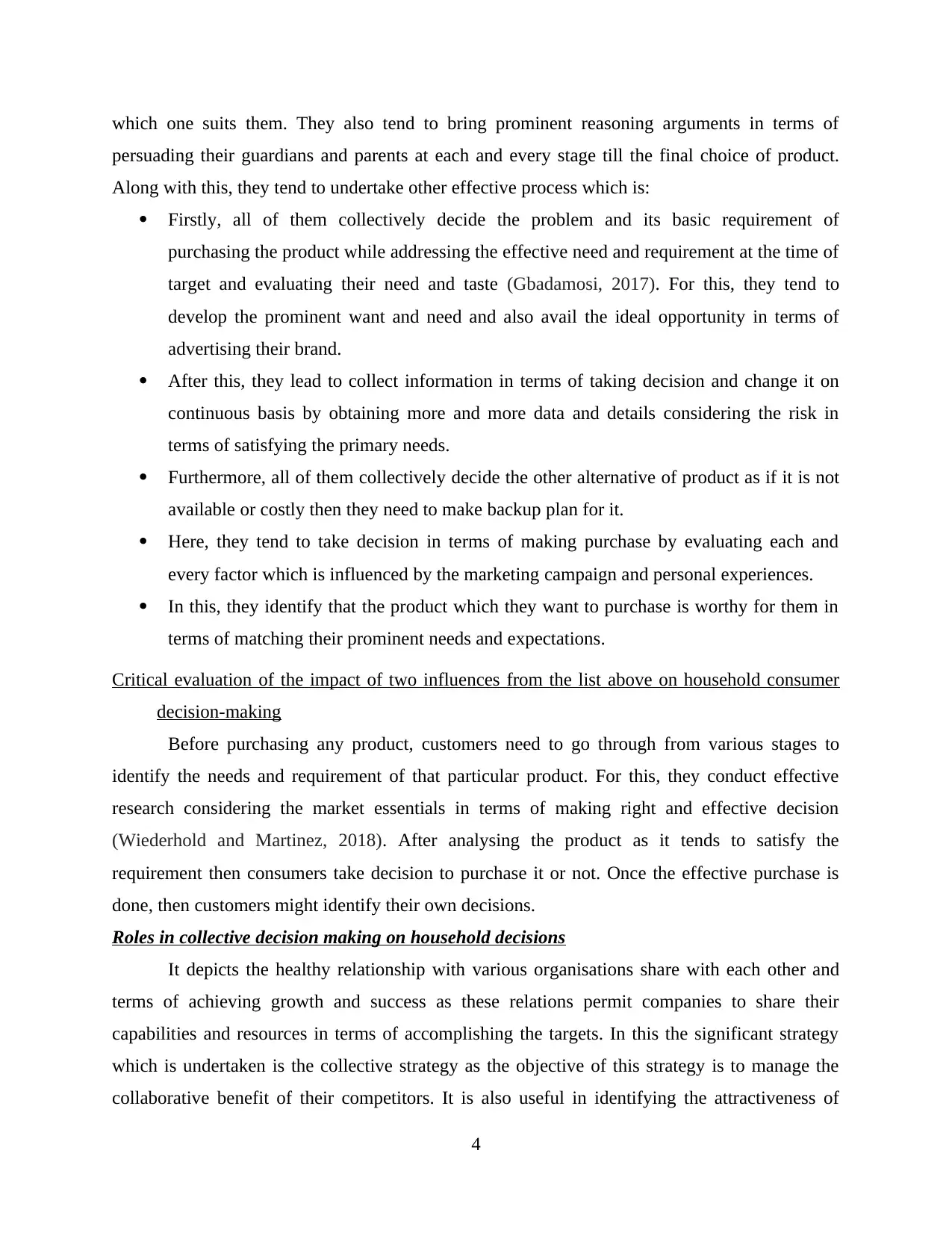
which one suits them. They also tend to bring prominent reasoning arguments in terms of
persuading their guardians and parents at each and every stage till the final choice of product.
Along with this, they tend to undertake other effective process which is:
Firstly, all of them collectively decide the problem and its basic requirement of
purchasing the product while addressing the effective need and requirement at the time of
target and evaluating their need and taste (Gbadamosi, 2017). For this, they tend to
develop the prominent want and need and also avail the ideal opportunity in terms of
advertising their brand.
After this, they lead to collect information in terms of taking decision and change it on
continuous basis by obtaining more and more data and details considering the risk in
terms of satisfying the primary needs.
Furthermore, all of them collectively decide the other alternative of product as if it is not
available or costly then they need to make backup plan for it.
Here, they tend to take decision in terms of making purchase by evaluating each and
every factor which is influenced by the marketing campaign and personal experiences.
In this, they identify that the product which they want to purchase is worthy for them in
terms of matching their prominent needs and expectations.
Critical evaluation of the impact of two influences from the list above on household consumer
decision-making
Before purchasing any product, customers need to go through from various stages to
identify the needs and requirement of that particular product. For this, they conduct effective
research considering the market essentials in terms of making right and effective decision
(Wiederhold and Martinez, 2018). After analysing the product as it tends to satisfy the
requirement then consumers take decision to purchase it or not. Once the effective purchase is
done, then customers might identify their own decisions.
Roles in collective decision making on household decisions
It depicts the healthy relationship with various organisations share with each other and
terms of achieving growth and success as these relations permit companies to share their
capabilities and resources in terms of accomplishing the targets. In this the significant strategy
which is undertaken is the collective strategy as the objective of this strategy is to manage the
collaborative benefit of their competitors. It is also useful in identifying the attractiveness of
4
persuading their guardians and parents at each and every stage till the final choice of product.
Along with this, they tend to undertake other effective process which is:
Firstly, all of them collectively decide the problem and its basic requirement of
purchasing the product while addressing the effective need and requirement at the time of
target and evaluating their need and taste (Gbadamosi, 2017). For this, they tend to
develop the prominent want and need and also avail the ideal opportunity in terms of
advertising their brand.
After this, they lead to collect information in terms of taking decision and change it on
continuous basis by obtaining more and more data and details considering the risk in
terms of satisfying the primary needs.
Furthermore, all of them collectively decide the other alternative of product as if it is not
available or costly then they need to make backup plan for it.
Here, they tend to take decision in terms of making purchase by evaluating each and
every factor which is influenced by the marketing campaign and personal experiences.
In this, they identify that the product which they want to purchase is worthy for them in
terms of matching their prominent needs and expectations.
Critical evaluation of the impact of two influences from the list above on household consumer
decision-making
Before purchasing any product, customers need to go through from various stages to
identify the needs and requirement of that particular product. For this, they conduct effective
research considering the market essentials in terms of making right and effective decision
(Wiederhold and Martinez, 2018). After analysing the product as it tends to satisfy the
requirement then consumers take decision to purchase it or not. Once the effective purchase is
done, then customers might identify their own decisions.
Roles in collective decision making on household decisions
It depicts the healthy relationship with various organisations share with each other and
terms of achieving growth and success as these relations permit companies to share their
capabilities and resources in terms of accomplishing the targets. In this the significant strategy
which is undertaken is the collective strategy as the objective of this strategy is to manage the
collaborative benefit of their competitors. It is also useful in identifying the attractiveness of
4
⊘ This is a preview!⊘
Do you want full access?
Subscribe today to unlock all pages.

Trusted by 1+ million students worldwide
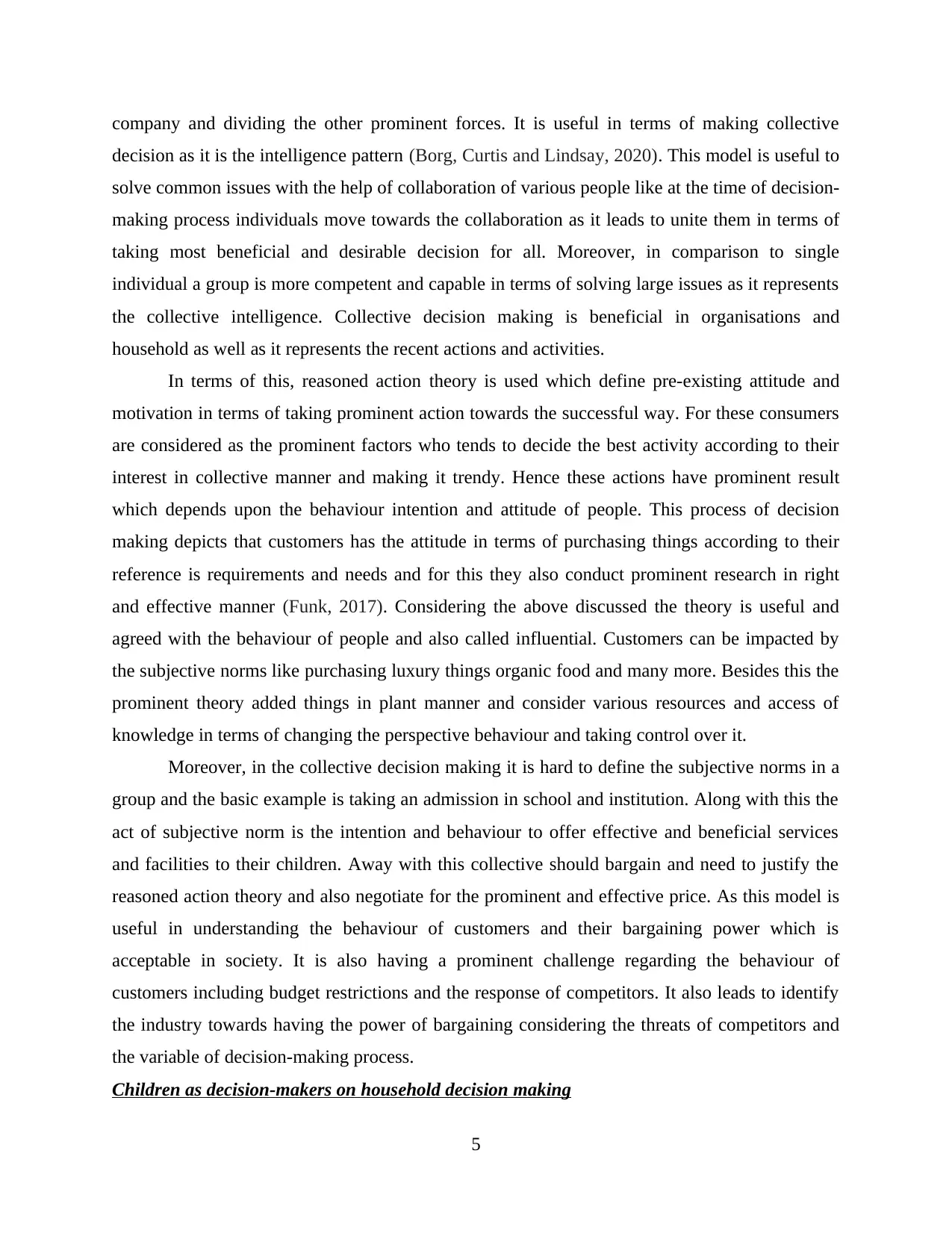
company and dividing the other prominent forces. It is useful in terms of making collective
decision as it is the intelligence pattern (Borg, Curtis and Lindsay, 2020). This model is useful to
solve common issues with the help of collaboration of various people like at the time of decision-
making process individuals move towards the collaboration as it leads to unite them in terms of
taking most beneficial and desirable decision for all. Moreover, in comparison to single
individual a group is more competent and capable in terms of solving large issues as it represents
the collective intelligence. Collective decision making is beneficial in organisations and
household as well as it represents the recent actions and activities.
In terms of this, reasoned action theory is used which define pre-existing attitude and
motivation in terms of taking prominent action towards the successful way. For these consumers
are considered as the prominent factors who tends to decide the best activity according to their
interest in collective manner and making it trendy. Hence these actions have prominent result
which depends upon the behaviour intention and attitude of people. This process of decision
making depicts that customers has the attitude in terms of purchasing things according to their
reference is requirements and needs and for this they also conduct prominent research in right
and effective manner (Funk, 2017). Considering the above discussed the theory is useful and
agreed with the behaviour of people and also called influential. Customers can be impacted by
the subjective norms like purchasing luxury things organic food and many more. Besides this the
prominent theory added things in plant manner and consider various resources and access of
knowledge in terms of changing the perspective behaviour and taking control over it.
Moreover, in the collective decision making it is hard to define the subjective norms in a
group and the basic example is taking an admission in school and institution. Along with this the
act of subjective norm is the intention and behaviour to offer effective and beneficial services
and facilities to their children. Away with this collective should bargain and need to justify the
reasoned action theory and also negotiate for the prominent and effective price. As this model is
useful in understanding the behaviour of customers and their bargaining power which is
acceptable in society. It is also having a prominent challenge regarding the behaviour of
customers including budget restrictions and the response of competitors. It also leads to identify
the industry towards having the power of bargaining considering the threats of competitors and
the variable of decision-making process.
Children as decision-makers on household decision making
5
decision as it is the intelligence pattern (Borg, Curtis and Lindsay, 2020). This model is useful to
solve common issues with the help of collaboration of various people like at the time of decision-
making process individuals move towards the collaboration as it leads to unite them in terms of
taking most beneficial and desirable decision for all. Moreover, in comparison to single
individual a group is more competent and capable in terms of solving large issues as it represents
the collective intelligence. Collective decision making is beneficial in organisations and
household as well as it represents the recent actions and activities.
In terms of this, reasoned action theory is used which define pre-existing attitude and
motivation in terms of taking prominent action towards the successful way. For these consumers
are considered as the prominent factors who tends to decide the best activity according to their
interest in collective manner and making it trendy. Hence these actions have prominent result
which depends upon the behaviour intention and attitude of people. This process of decision
making depicts that customers has the attitude in terms of purchasing things according to their
reference is requirements and needs and for this they also conduct prominent research in right
and effective manner (Funk, 2017). Considering the above discussed the theory is useful and
agreed with the behaviour of people and also called influential. Customers can be impacted by
the subjective norms like purchasing luxury things organic food and many more. Besides this the
prominent theory added things in plant manner and consider various resources and access of
knowledge in terms of changing the perspective behaviour and taking control over it.
Moreover, in the collective decision making it is hard to define the subjective norms in a
group and the basic example is taking an admission in school and institution. Along with this the
act of subjective norm is the intention and behaviour to offer effective and beneficial services
and facilities to their children. Away with this collective should bargain and need to justify the
reasoned action theory and also negotiate for the prominent and effective price. As this model is
useful in understanding the behaviour of customers and their bargaining power which is
acceptable in society. It is also having a prominent challenge regarding the behaviour of
customers including budget restrictions and the response of competitors. It also leads to identify
the industry towards having the power of bargaining considering the threats of competitors and
the variable of decision-making process.
Children as decision-makers on household decision making
5
Paraphrase This Document
Need a fresh take? Get an instant paraphrase of this document with our AI Paraphraser
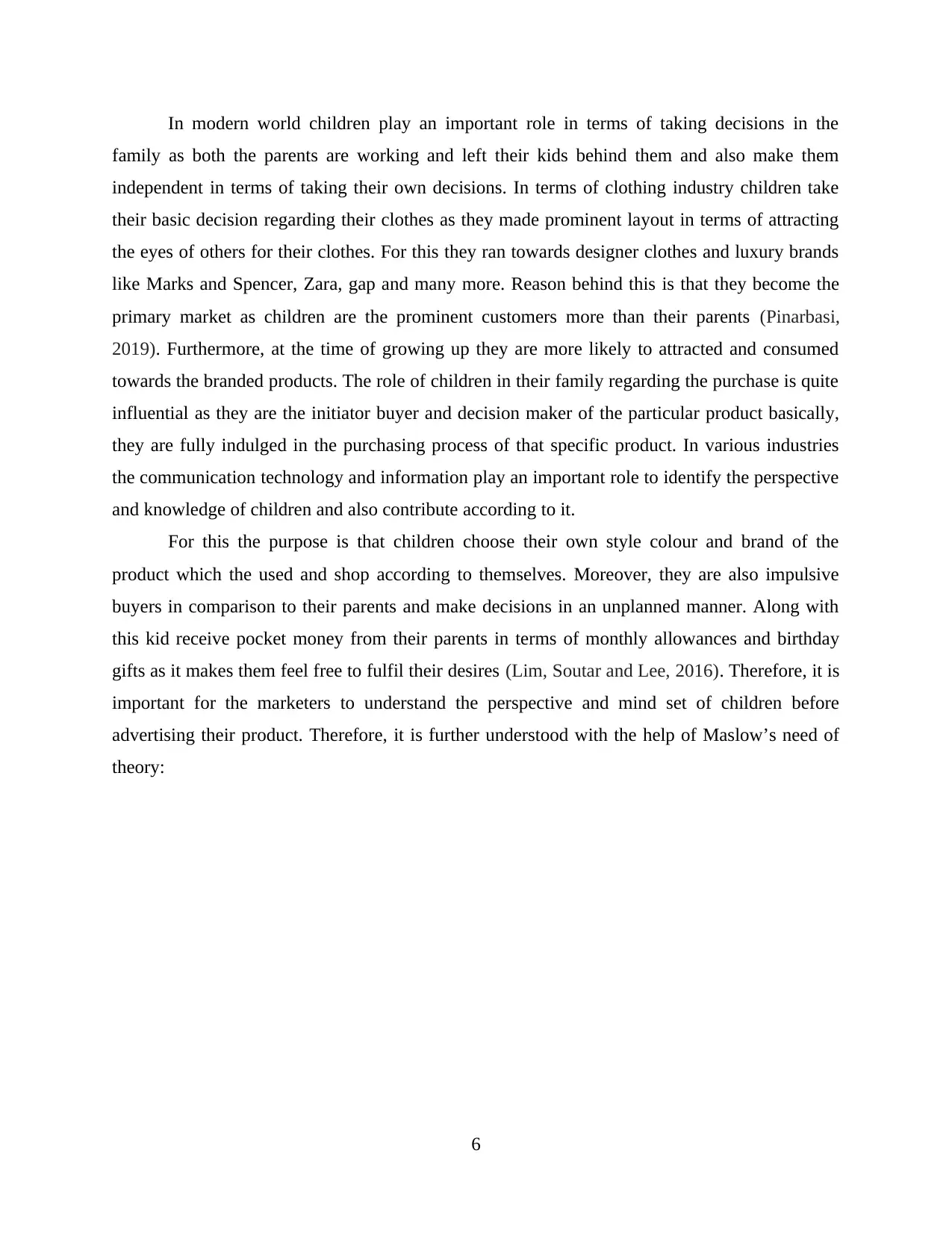
In modern world children play an important role in terms of taking decisions in the
family as both the parents are working and left their kids behind them and also make them
independent in terms of taking their own decisions. In terms of clothing industry children take
their basic decision regarding their clothes as they made prominent layout in terms of attracting
the eyes of others for their clothes. For this they ran towards designer clothes and luxury brands
like Marks and Spencer, Zara, gap and many more. Reason behind this is that they become the
primary market as children are the prominent customers more than their parents (Pinarbasi,
2019). Furthermore, at the time of growing up they are more likely to attracted and consumed
towards the branded products. The role of children in their family regarding the purchase is quite
influential as they are the initiator buyer and decision maker of the particular product basically,
they are fully indulged in the purchasing process of that specific product. In various industries
the communication technology and information play an important role to identify the perspective
and knowledge of children and also contribute according to it.
For this the purpose is that children choose their own style colour and brand of the
product which the used and shop according to themselves. Moreover, they are also impulsive
buyers in comparison to their parents and make decisions in an unplanned manner. Along with
this kid receive pocket money from their parents in terms of monthly allowances and birthday
gifts as it makes them feel free to fulfil their desires (Lim, Soutar and Lee, 2016). Therefore, it is
important for the marketers to understand the perspective and mind set of children before
advertising their product. Therefore, it is further understood with the help of Maslow’s need of
theory:
6
family as both the parents are working and left their kids behind them and also make them
independent in terms of taking their own decisions. In terms of clothing industry children take
their basic decision regarding their clothes as they made prominent layout in terms of attracting
the eyes of others for their clothes. For this they ran towards designer clothes and luxury brands
like Marks and Spencer, Zara, gap and many more. Reason behind this is that they become the
primary market as children are the prominent customers more than their parents (Pinarbasi,
2019). Furthermore, at the time of growing up they are more likely to attracted and consumed
towards the branded products. The role of children in their family regarding the purchase is quite
influential as they are the initiator buyer and decision maker of the particular product basically,
they are fully indulged in the purchasing process of that specific product. In various industries
the communication technology and information play an important role to identify the perspective
and knowledge of children and also contribute according to it.
For this the purpose is that children choose their own style colour and brand of the
product which the used and shop according to themselves. Moreover, they are also impulsive
buyers in comparison to their parents and make decisions in an unplanned manner. Along with
this kid receive pocket money from their parents in terms of monthly allowances and birthday
gifts as it makes them feel free to fulfil their desires (Lim, Soutar and Lee, 2016). Therefore, it is
important for the marketers to understand the perspective and mind set of children before
advertising their product. Therefore, it is further understood with the help of Maslow’s need of
theory:
6
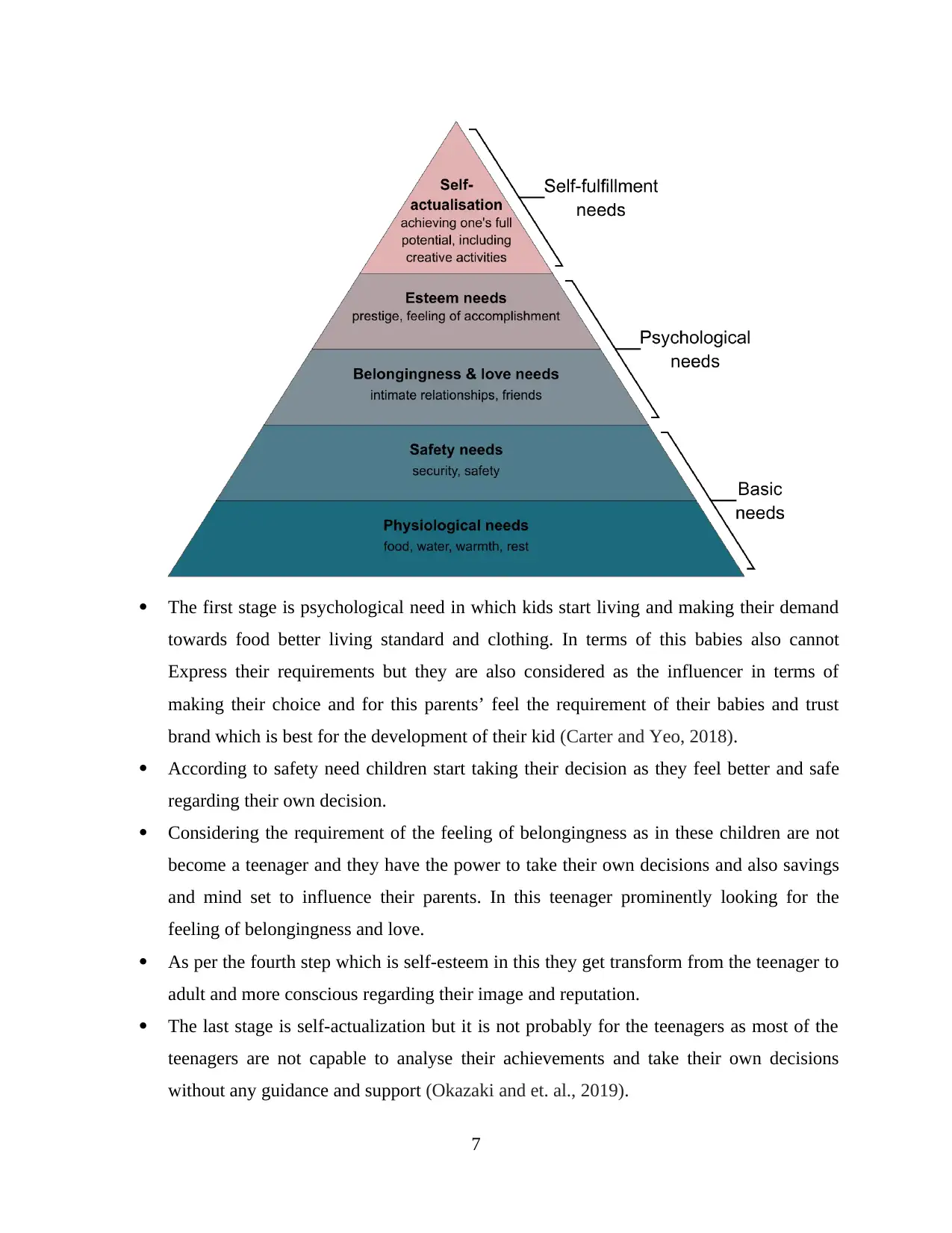
The first stage is psychological need in which kids start living and making their demand
towards food better living standard and clothing. In terms of this babies also cannot
Express their requirements but they are also considered as the influencer in terms of
making their choice and for this parents’ feel the requirement of their babies and trust
brand which is best for the development of their kid (Carter and Yeo, 2018).
According to safety need children start taking their decision as they feel better and safe
regarding their own decision.
Considering the requirement of the feeling of belongingness as in these children are not
become a teenager and they have the power to take their own decisions and also savings
and mind set to influence their parents. In this teenager prominently looking for the
feeling of belongingness and love.
As per the fourth step which is self-esteem in this they get transform from the teenager to
adult and more conscious regarding their image and reputation.
The last stage is self-actualization but it is not probably for the teenagers as most of the
teenagers are not capable to analyse their achievements and take their own decisions
without any guidance and support (Okazaki and et. al., 2019).
7
towards food better living standard and clothing. In terms of this babies also cannot
Express their requirements but they are also considered as the influencer in terms of
making their choice and for this parents’ feel the requirement of their babies and trust
brand which is best for the development of their kid (Carter and Yeo, 2018).
According to safety need children start taking their decision as they feel better and safe
regarding their own decision.
Considering the requirement of the feeling of belongingness as in these children are not
become a teenager and they have the power to take their own decisions and also savings
and mind set to influence their parents. In this teenager prominently looking for the
feeling of belongingness and love.
As per the fourth step which is self-esteem in this they get transform from the teenager to
adult and more conscious regarding their image and reputation.
The last stage is self-actualization but it is not probably for the teenagers as most of the
teenagers are not capable to analyse their achievements and take their own decisions
without any guidance and support (Okazaki and et. al., 2019).
7
⊘ This is a preview!⊘
Do you want full access?
Subscribe today to unlock all pages.

Trusted by 1+ million students worldwide
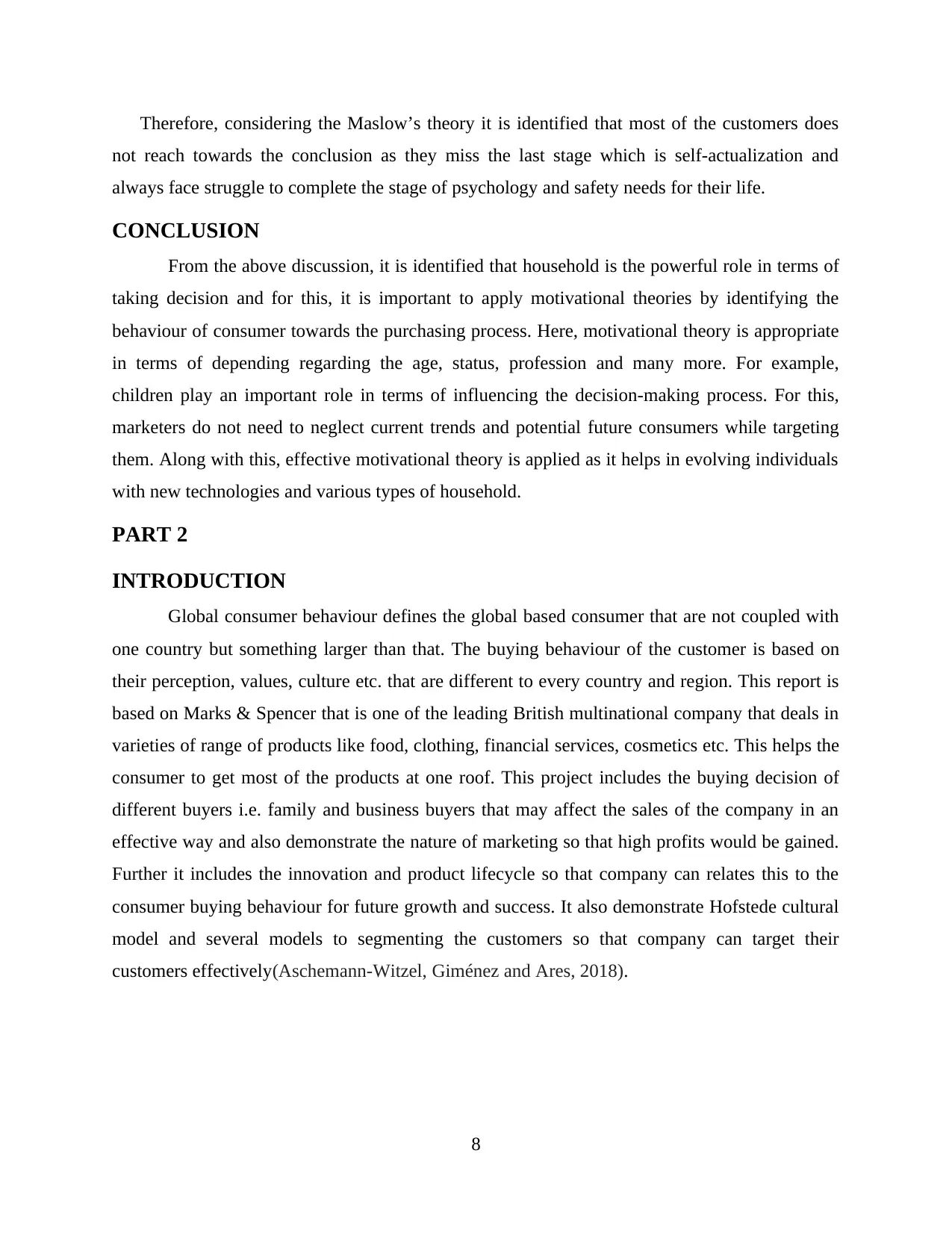
Therefore, considering the Maslow’s theory it is identified that most of the customers does
not reach towards the conclusion as they miss the last stage which is self-actualization and
always face struggle to complete the stage of psychology and safety needs for their life.
CONCLUSION
From the above discussion, it is identified that household is the powerful role in terms of
taking decision and for this, it is important to apply motivational theories by identifying the
behaviour of consumer towards the purchasing process. Here, motivational theory is appropriate
in terms of depending regarding the age, status, profession and many more. For example,
children play an important role in terms of influencing the decision-making process. For this,
marketers do not need to neglect current trends and potential future consumers while targeting
them. Along with this, effective motivational theory is applied as it helps in evolving individuals
with new technologies and various types of household.
PART 2
INTRODUCTION
Global consumer behaviour defines the global based consumer that are not coupled with
one country but something larger than that. The buying behaviour of the customer is based on
their perception, values, culture etc. that are different to every country and region. This report is
based on Marks & Spencer that is one of the leading British multinational company that deals in
varieties of range of products like food, clothing, financial services, cosmetics etc. This helps the
consumer to get most of the products at one roof. This project includes the buying decision of
different buyers i.e. family and business buyers that may affect the sales of the company in an
effective way and also demonstrate the nature of marketing so that high profits would be gained.
Further it includes the innovation and product lifecycle so that company can relates this to the
consumer buying behaviour for future growth and success. It also demonstrate Hofstede cultural
model and several models to segmenting the customers so that company can target their
customers effectively(Aschemann-Witzel, Giménez and Ares, 2018).
8
not reach towards the conclusion as they miss the last stage which is self-actualization and
always face struggle to complete the stage of psychology and safety needs for their life.
CONCLUSION
From the above discussion, it is identified that household is the powerful role in terms of
taking decision and for this, it is important to apply motivational theories by identifying the
behaviour of consumer towards the purchasing process. Here, motivational theory is appropriate
in terms of depending regarding the age, status, profession and many more. For example,
children play an important role in terms of influencing the decision-making process. For this,
marketers do not need to neglect current trends and potential future consumers while targeting
them. Along with this, effective motivational theory is applied as it helps in evolving individuals
with new technologies and various types of household.
PART 2
INTRODUCTION
Global consumer behaviour defines the global based consumer that are not coupled with
one country but something larger than that. The buying behaviour of the customer is based on
their perception, values, culture etc. that are different to every country and region. This report is
based on Marks & Spencer that is one of the leading British multinational company that deals in
varieties of range of products like food, clothing, financial services, cosmetics etc. This helps the
consumer to get most of the products at one roof. This project includes the buying decision of
different buyers i.e. family and business buyers that may affect the sales of the company in an
effective way and also demonstrate the nature of marketing so that high profits would be gained.
Further it includes the innovation and product lifecycle so that company can relates this to the
consumer buying behaviour for future growth and success. It also demonstrate Hofstede cultural
model and several models to segmenting the customers so that company can target their
customers effectively(Aschemann-Witzel, Giménez and Ares, 2018).
8
Paraphrase This Document
Need a fresh take? Get an instant paraphrase of this document with our AI Paraphraser
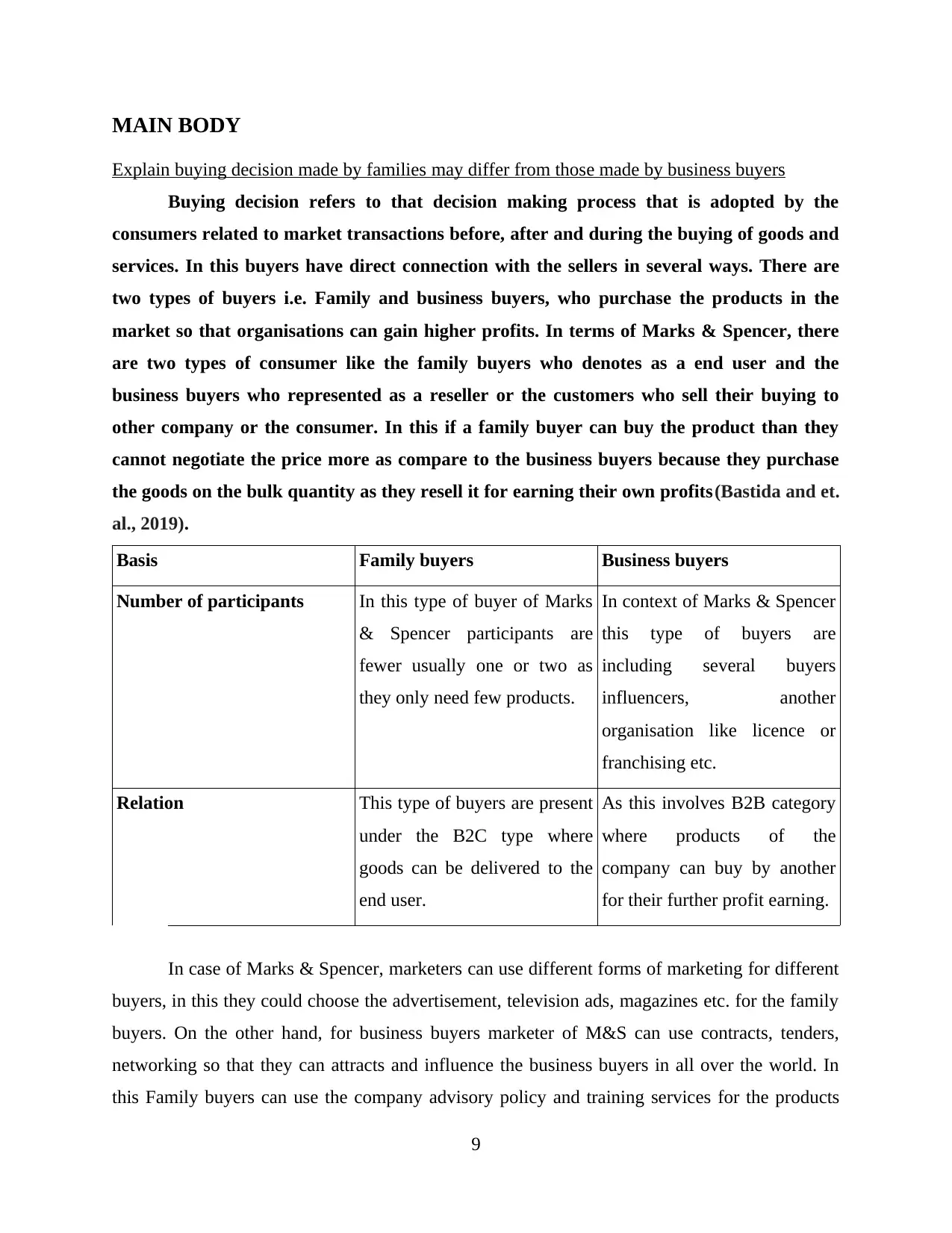
MAIN BODY
Explain buying decision made by families may differ from those made by business buyers
Buying decision refers to that decision making process that is adopted by the
consumers related to market transactions before, after and during the buying of goods and
services. In this buyers have direct connection with the sellers in several ways. There are
two types of buyers i.e. Family and business buyers, who purchase the products in the
market so that organisations can gain higher profits. In terms of Marks & Spencer, there
are two types of consumer like the family buyers who denotes as a end user and the
business buyers who represented as a reseller or the customers who sell their buying to
other company or the consumer. In this if a family buyer can buy the product than they
cannot negotiate the price more as compare to the business buyers because they purchase
the goods on the bulk quantity as they resell it for earning their own profits(Bastida and et.
al., 2019).
Basis Family buyers Business buyers
Number of participants In this type of buyer of Marks
& Spencer participants are
fewer usually one or two as
they only need few products.
In context of Marks & Spencer
this type of buyers are
including several buyers
influencers, another
organisation like licence or
franchising etc.
Relation This type of buyers are present
under the B2C type where
goods can be delivered to the
end user.
As this involves B2B category
where products of the
company can buy by another
for their further profit earning.
In case of Marks & Spencer, marketers can use different forms of marketing for different
buyers, in this they could choose the advertisement, television ads, magazines etc. for the family
buyers. On the other hand, for business buyers marketer of M&S can use contracts, tenders,
networking so that they can attracts and influence the business buyers in all over the world. In
this Family buyers can use the company advisory policy and training services for the products
9
Explain buying decision made by families may differ from those made by business buyers
Buying decision refers to that decision making process that is adopted by the
consumers related to market transactions before, after and during the buying of goods and
services. In this buyers have direct connection with the sellers in several ways. There are
two types of buyers i.e. Family and business buyers, who purchase the products in the
market so that organisations can gain higher profits. In terms of Marks & Spencer, there
are two types of consumer like the family buyers who denotes as a end user and the
business buyers who represented as a reseller or the customers who sell their buying to
other company or the consumer. In this if a family buyer can buy the product than they
cannot negotiate the price more as compare to the business buyers because they purchase
the goods on the bulk quantity as they resell it for earning their own profits(Bastida and et.
al., 2019).
Basis Family buyers Business buyers
Number of participants In this type of buyer of Marks
& Spencer participants are
fewer usually one or two as
they only need few products.
In context of Marks & Spencer
this type of buyers are
including several buyers
influencers, another
organisation like licence or
franchising etc.
Relation This type of buyers are present
under the B2C type where
goods can be delivered to the
end user.
As this involves B2B category
where products of the
company can buy by another
for their further profit earning.
In case of Marks & Spencer, marketers can use different forms of marketing for different
buyers, in this they could choose the advertisement, television ads, magazines etc. for the family
buyers. On the other hand, for business buyers marketer of M&S can use contracts, tenders,
networking so that they can attracts and influence the business buyers in all over the world. In
this Family buyers can use the company advisory policy and training services for the products
9
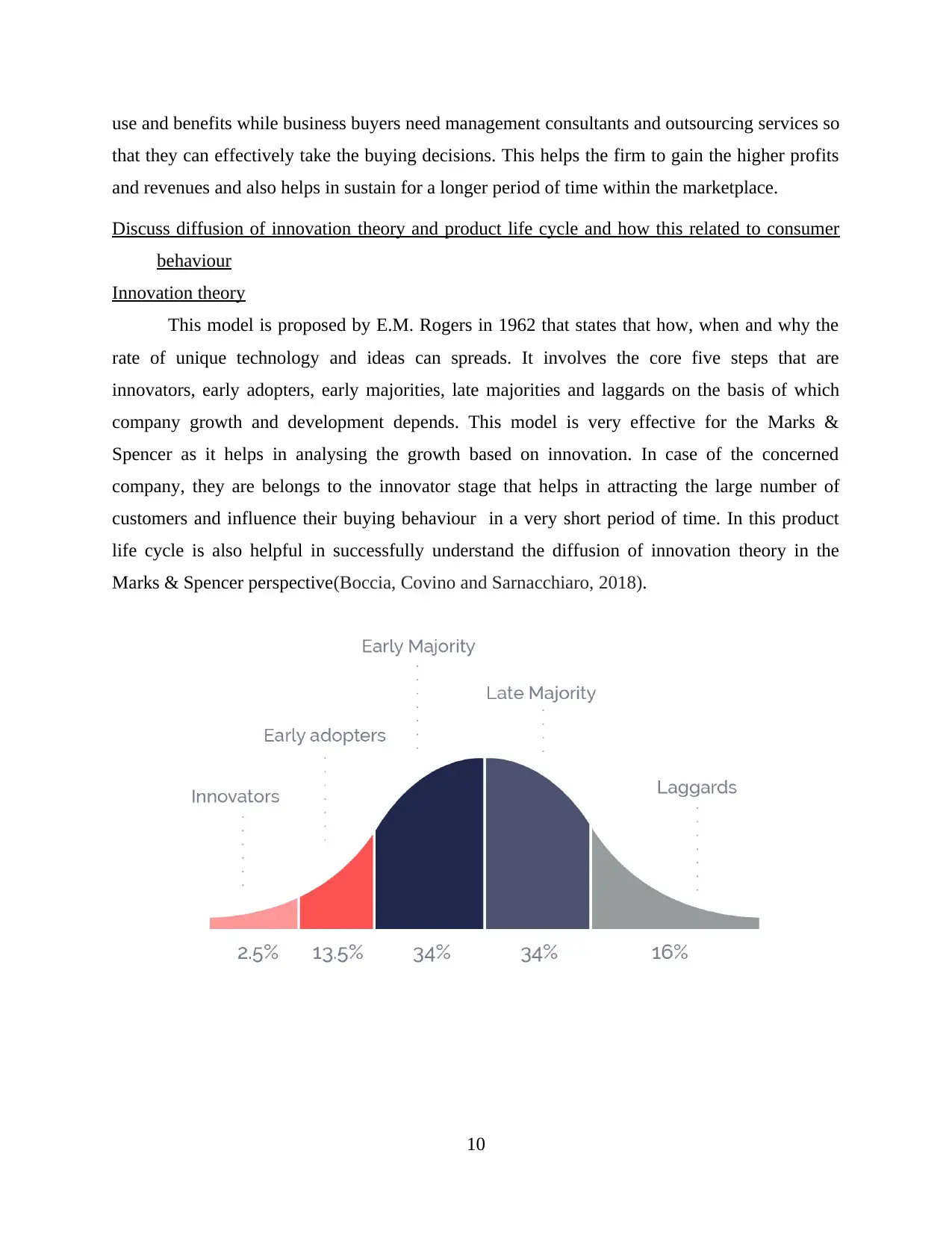
use and benefits while business buyers need management consultants and outsourcing services so
that they can effectively take the buying decisions. This helps the firm to gain the higher profits
and revenues and also helps in sustain for a longer period of time within the marketplace.
Discuss diffusion of innovation theory and product life cycle and how this related to consumer
behaviour
Innovation theory
This model is proposed by E.M. Rogers in 1962 that states that how, when and why the
rate of unique technology and ideas can spreads. It involves the core five steps that are
innovators, early adopters, early majorities, late majorities and laggards on the basis of which
company growth and development depends. This model is very effective for the Marks &
Spencer as it helps in analysing the growth based on innovation. In case of the concerned
company, they are belongs to the innovator stage that helps in attracting the large number of
customers and influence their buying behaviour in a very short period of time. In this product
life cycle is also helpful in successfully understand the diffusion of innovation theory in the
Marks & Spencer perspective(Boccia, Covino and Sarnacchiaro, 2018).
10
that they can effectively take the buying decisions. This helps the firm to gain the higher profits
and revenues and also helps in sustain for a longer period of time within the marketplace.
Discuss diffusion of innovation theory and product life cycle and how this related to consumer
behaviour
Innovation theory
This model is proposed by E.M. Rogers in 1962 that states that how, when and why the
rate of unique technology and ideas can spreads. It involves the core five steps that are
innovators, early adopters, early majorities, late majorities and laggards on the basis of which
company growth and development depends. This model is very effective for the Marks &
Spencer as it helps in analysing the growth based on innovation. In case of the concerned
company, they are belongs to the innovator stage that helps in attracting the large number of
customers and influence their buying behaviour in a very short period of time. In this product
life cycle is also helpful in successfully understand the diffusion of innovation theory in the
Marks & Spencer perspective(Boccia, Covino and Sarnacchiaro, 2018).
10
⊘ This is a preview!⊘
Do you want full access?
Subscribe today to unlock all pages.

Trusted by 1+ million students worldwide
1 out of 19
Related Documents
Your All-in-One AI-Powered Toolkit for Academic Success.
+13062052269
info@desklib.com
Available 24*7 on WhatsApp / Email
![[object Object]](/_next/static/media/star-bottom.7253800d.svg)
Unlock your academic potential
Copyright © 2020–2025 A2Z Services. All Rights Reserved. Developed and managed by ZUCOL.





